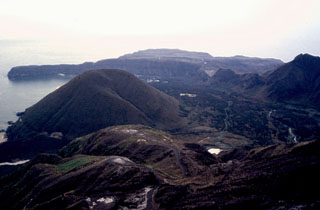Report on Kikai (Japan) — 30 October-5 November 2019
Smithsonian Institution / US Geological Survey
Weekly Volcanic Activity Report, 30 October-5 November 2019
Managing Editor: Sally Sennert.
Please cite this report as:
Global Volcanism Program, 2019. Report on Kikai (Japan) (Sennert, S, ed.). Weekly Volcanic Activity Report, 30 October-5 November 2019. Smithsonian Institution and US Geological Survey.
Kikai
Japan
30.793°N, 130.305°E; summit elev. 704 m
All times are local (unless otherwise noted)
An eruption at Satsuma Iwo-jima, a subaerial part of Kikai’s NW caldera rim, was detected at 1735 on 2 November, prompting JMA to raise the Alert Level to 2 (on a 5-level scale). A grayish-white plume rose 1 km above the Iodake crater rim. The report noted that the number of volcanic earthquakes has been low, with no variations before or after the event. The next day during an overflight conducted by the Coast Guard and the Japan Meteorological Agency Mobile Survey Team (JMA-MOT) observers noted no changes to the geothermal field and no new deposits from the event the day before. Views of the crater were obscured by white plumes rising 300 m above the crater rim.
Geological Summary. Multiple eruption centers have exhibited recent activity at Kikai, a mostly submerged, 19-km-wide caldera near the northern end of the Ryukyu Islands south of Kyushu. It was the source of one of the world's largest Holocene eruptions about 6,300 years ago when rhyolitic pyroclastic flows traveled across the sea for a total distance of 100 km to southern Kyushu, and ashfall reached the northern Japanese island of Hokkaido. The eruption devastated southern and central Kyushu, which remained uninhabited for several centuries. Post-caldera eruptions formed Iodake (or Iwo-dake) lava dome and Inamuradake scoria cone, as well as submarine lava domes. Recorded eruptions have occurred at or near Satsuma-Iojima (also known as Tokara-Iojima), a small 3 x 6 km island forming part of the NW caldera rim. Showa-Iojima lava dome (also known as Iojima-Shinto), a small island 2 km E of Satsuma-Iojima, was formed during submarine eruptions in 1934 and 1935. Mild-to-moderate explosive eruptions have occurred during the past few decades from Iodake, a rhyolitic lava dome at the eastern end of Satsuma-Iojima.

